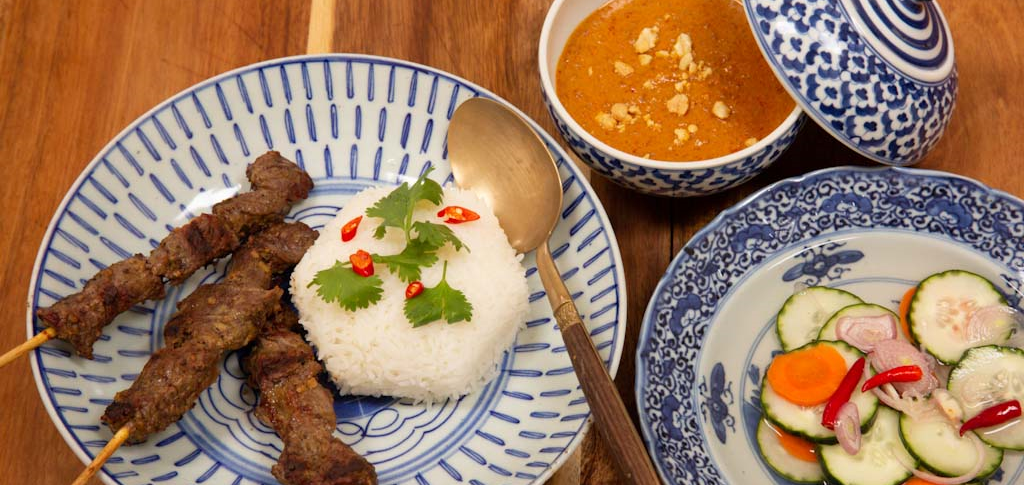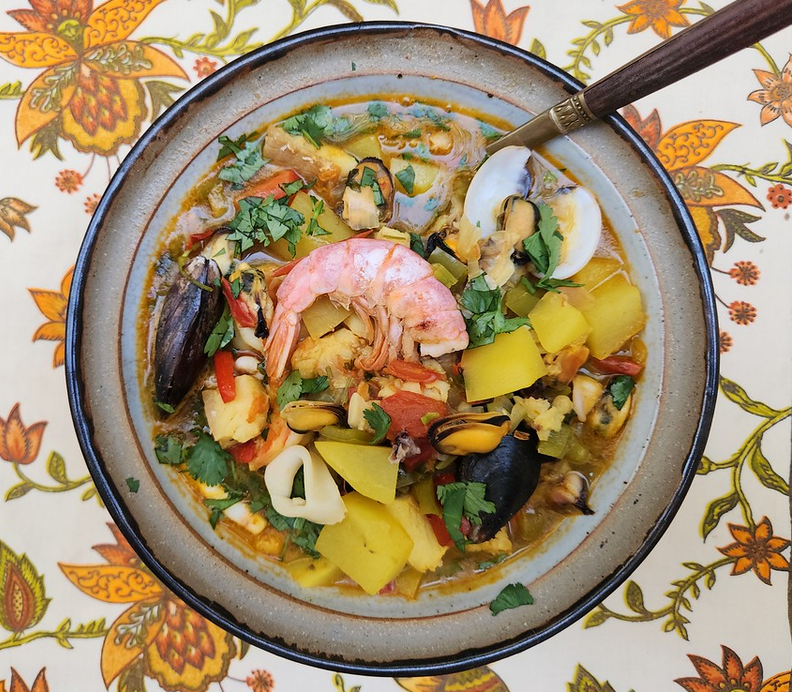The Participant Observer Recipe of the Month is Thai Beef Satay. A ubiquitous street food in Southeast Asia, satay is the perfect savory snack. The ingredients are nowadays easy to find, and satay is a wonderful treat to eat with friends on a summer's eve.

Satay*, skewered meat grilled and eaten with a dipping sauce (typically, but not always, a spicy peanut sauce) is thought to have its origins in the Indonesian archipelago. However, it is now found in various forms throughout Southeast Asia. The meats or protein sources that can be prepared as satay are nearly endless and include beef, pork, chicken, fish shellfish, tofu, tempeh (fermented soybeans), eggs, offal, snake, and more. Satay is similar to kabobs, but in Southeast Asia, the meat is more thinly sliced and not bunched and folded on the skewer. Many of the recipes I checked out on the web suggest skewering cubes of meat, but this is not as common in Southeast Asia and using cubes is somewhat antithetical to the rather unique taste and texture of satay.
Satay is grilled. Authentically it is grilled over coals. Often the charcoal used is made from coconut husks. Amazon sells coconut charcoal briquettes, but you can certainly use standard briquettes or a propane stove.
It is best to use smaller bamboo skewers. The goal is not to stuff as many pieces of meat on a skewer as is possible. One does not eat a single skewer of satay—one eats many! It is best to use top sirloin, flank or skirt steak that is cut across the grain. The meat will be marinated which will make it more tender, but sate should be a little bit chewy, not a melt-in-the-mouth experience.
This recipe uses a spicy peanut sauce. There are different ways in which you can make the peanut sauce; some people like it smooth and some like it a bit chunky. I like a smoother sauce, but my wife prefers the sauce to have a bit more texture to it. It's up to you. Some cooks insist on grinding their own peanuts (using unflavored dry roasted ones), but in "all-natural" peanut butter such as Smuckers, the only ingredients are peanuts and salt. Other "natural" peanut butter from popular brands (like Skippy or Jif) may have added sugar, molasses, palm or "partially hydrogenated" oils. Read the labels before you buy. The peanut sauce is made spicy with red Thai curry paste. Its smoothness is created by adding coconut cream or coconut milk.
Canned coconut milk often has guar gum added to it to make it more shelf-stable and thicker. My personal preference is to use coconut milk, which is just coconuts and water. The problem with coconut milk that has stabilizers is that they are difficult to use for dishes that are purposely cooked to the point of the oil separating from the coconut milk. Emulsifiers prevent this from happening and so, for dishes like rendang or the peanut sauce described here, pure coconut milk—without guar gum or other stabilizing or emulsifying ingredients is desirable. Coconut milk is made by shredding raw coconut and then mixing it with very hot water. The coconut meat is then pressed dry and what remains is coconut milk. Coconut water is very different; it is the liquid that is inside a young (or at least not old) coconut. It is not made by squeezing coconut meat in hot water. Like other expressed oils, there may be a "first pressing" (highest quality) and then subsequent pressings which are somewhat less robust. Coconut cream has more fat (and less water) than regular coconut milk. I've read a couple of online articles that suggest that first pressings or coconut cream is preferred for desserts and latter pressings for curries and soups, but my personal experience living in a small Indonesian village for several years is that people grate coconut and then use the first pressing for just about everything. Another thing to know about coconut milk is that it spoils rather quickly after the can or carton is opened. After a few days, it will go off. Apparently, coconut milk freezes well, so that might be a solution.
There are many different kinds of dipping sauces that are used with satay, but surely the most common is peanut sauce, both here and in Southeast Asia. Satay is almost always eaten with rice. In West Sumatra, it is eaten with pressed rice cakes known as katupek which is rice cooked in a container that limits the expansion of the rice, resulting in a rice cake that is solid and uniform in texture. Katepek is traditionally made in small pouches of woven palm strips. Lontong is similar but uses rolled banana leaves and lemang uses tubes of bamboo to compress the rice. Yet another option (suggested by Pailin Chongchitnant's recipe for Beef Satay, for which this recipe is, in part, based on) is to eat the satay with sliced white bread.
Regarding spices: This recipe, like so many other curry-related recipes from South and Southeast Asia uses spices that are roasted (coriander and cumin seeds) and then ground. Reversing that order (or using pre-ground spices) is somewhat difficult—but not impossible—because it is a challenge to roast ground spices evenly. Roast the spices in a 300 F° oven or in a medium-hot dry frying pan. The goal is to darken the seeds without burning them. Roasting a small amount as is called for in this recipe is somewhat impractical. It is best to roast 1/2 cup of the cumin and 3/4 cup of coriander seeds and then store what you don't use. It is best to roast them separately because the cumin seed, being smaller, will brown faster than the coriander seeds.
An ingredient that some cooks might be unfamiliar with is tamarind which adds tartness and a slight sweetness to the peanut sauce. Tamarind can be found in a variety of forms: fresh, as a pulp, or as a liquid. You might also find "tamarind sauce" or "tamarind chutney" but both of these have added spices that are not suitable for the peanut sauce in this recipe. Tamarind pulp (with or without seeds) is the best choice, but tamarind paste is a close 2nd and doesn't require extra effort. To make the tamarind juice for this recipe, break or cut off a small handful of tamarind pulp and soak it in a cup of boiling water. After the water has cooled, massage the tamarind pulp to dissolve as much of the tamarind from the fibrous material. To obtain the tamarind juice, strain the pulp. If it is too thick to strain, mix some water into the pulp, but only as much as needed to enable straining. If using tamarind paste, or substituting with lime juice, use half as much.
A good-sized mortar and pestle is a valuable asset in making this dish. Otherwise, you may need to use both a spice grinder and a food processor. A larger size mortar and pestle are preferable to smaller-sized ones; they require less effort to pound seeds and smaller-sized mortar and pestles tend to jettison ingredients. You can use both a spice grinder and food processor to make the marinade and peanut sauce, but using a large mortar and pestle requires fewer steps and less clean-up.
* "Satay" is a romanization of สะเต๊ะ, (Thai). However, the word is derived from Malay or Indonesia where it is now spelled "sate". Since this recipe is a Thai, rather than Indoneisian version, I used the Thai romanization throughout.
Ingredients:
- 1 lb beef (flank, skirt, or top sirloin)
- bamboo skewers(6- 10 inch)
- 2 cups of Jasmine rice
Marinade Ingredients
- 1 1/2 teaspoon coriander seeds, toasted
- 1 teaspoon cumin seeds, toasted
- 1/2 teaspoon black peppercorns
- 2 garlic cloves
- 1 shallot
- 2 tablespoons lemongrass, thinly sliced
- 2 tablespoons galangal, chopped very fine (if available, otherwise substitute fresh ginger.)
- 1 teaspoon ground turmeric
- 1/4 teaspoon ground cinnamon
- 2 teaspoons sugar (palm, brown or white cane sugar)
- ½ teaspoon salt
- 2 tablespoons lime juice or 1 tablespoon white vinegar
- 2/3 cup coconut milk
Peanut Sauce Ingredients
- 2 tablespoons Thai red curry paste
- 1 1/4 cup coconut milk
- 1 cup dry roasted peanuts or 1/2 cup natural peanut butter
- 1 1/2 teaspoon Thai fish sauce
- 2 tablespoons granulated palm, brown or white sugar
- 2 tablespoons tamarind water, or 1 tablespoon tamarind paste, or 1 tablespoon lime juice
- 3 kaffir lime leaves
Cucumber/Vinegar Salad (mix all ingredients together)
- 1 cucumber, either diced small or sliced thin (Note: if you score the cucumber lenghtwise with a fork before slicing, it looks fancy!)
- 1-4 hot Thai chilies, sliced very thin
- 1/4 of a medium onion, or 4-5 scallions sliced very thin
- 1 cup rice or white vinegar
- 1/2 cup white sugar
- 2 teaspoon salt
Preparation:
- It is best to marinate the beef and soak the skewers in water the night before making this recipe.*
- For the marinade, combine all the roasted and dried spices and grind them to a fine powder (see notes above regarding mortars, pestles, and food processors).
- Add the thinly sliced lemongrass and galangal and grind.
- Mix in the lime juice (or vinegar) and coconut milk.
- Cut the beef across the grain into thin (1/4") strips.
- Cut the strips into pieces that are flat squares.
- In a bag, container or bowl, marinate the sliced beef for several hours or overnight. Massaging the marinade into the beef is recommended.
- After the beef is fully marinated, skewer the beef through the flat dimension (see picture).
- Set aside the beef and cook the rice according to the package directions.
- If you are using roasted peanuts (as opposed to peanut butter), grind them.
- In a small pot mix the red curry paste with the coconut milk.
- Cook the curry paste in the coconut milk on medium heat until the oil from the coconut milk begins to separate.
- Add the remaining sauce ingredients and mix thoroughly.
- Cook on medium heat for 5 minutes, and thin the sauce with water if needed. Adding water will make the sauce creamy. It's rather magical.
- Rev your grill up to high.
- Grill the satay on both sides, and baste them with coconut milk before you turn them over. A slight char is desirable.
- Serve with rice and cucumber salad.
*If you forget to soak the skewers, you can create a thick fold of aluminum foil and place it both above and below the exposed ends of the skewers. It is a bit tricky to do this over a hot grill, be careful!
Recipe: T. Johnston-O'Neill
Photos: Kathleen Johnston








